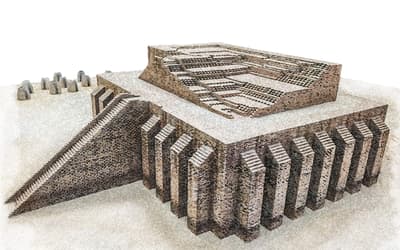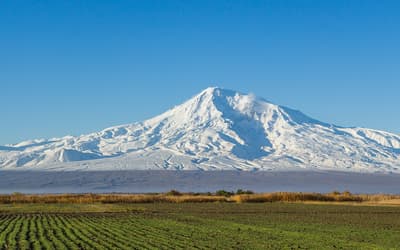The views expressed in this paper are those of the writer(s) and are not necessarily those of the ARJ Editor or Answers in Genesis.
Abstract
This reply to Osgood’s (2024) comments will show that locating the Tower of Babel in the north of Mesopotamia is supported by the intensive use of geology, linguistics, history, and geography; and Babel cannot have been Babylon in South Mesopotamia, which was under water when the Tower was being built. The traditional belief that Babel and Babylon were the same place, located in south Mesopotamia, does not stand up under critical scholarship. Merely because many people have believed something for a long time does not make that belief truth.
Keywords: Babel, Babylon, Shinar, Sumer, science, archaeology, history, linguistics
Introduction
It is now 13 years since I published “Where in the World is the Tower of Babel?” an extensive, in-depth paper showing why the Tower had to have been built in Northern Mesopotamia (Habermehl 2011). During that time nobody has challenged my arguments and conclusions until now (Osgood 2024). I will show here that Osgood’s claims do not stand up, and that he is merely promoting the long-held traditional view that I overturned in that paper, namely, that Babel and Babylon are the same place and are located in southern Mesopotamia.
Science and Proof
Osgood’s position that history and archaeology override science is nothing but an unsupported hypothesis. Obviously he has to cast doubt on science if he wants to overturn what I have shown scientifically in that paper, and he has an agenda for doing that, as we shall see. But he needs to beware. If he is going to override the science presented in that paper, he will first have to refute it. Not surprisingly, he has not done this.
Why does he want to belittle science? It is because my scientific arguments arrive at conclusions that he does not want to accept. In the world of scholarship, claiming that an unwelcome conclusion is nothing but a theory (as Osgood does) is not a good argument. In fact, it is no argument at all. If proven scientific facts are not in agreement with what we want to believe, there is something wrong with our belief.
Specifically, it is geology that is Osgood’s problem and nemesis. Geology shows that the southern half of Iraq (Lower Mesopotamia) is a delta formed by sediments washed down from the Turkish mountains in the north and the Zagros mountains on the east. It is the catastrophic meltdown of the ice built up during the Ice Age that produced the delta deposits. This means that all structures on that delta were built only after the Ice Age was over. Babel in Shinar was built north of that delta, north of its ancient shoreline, before the ice meltdown, when the area of the delta was under water. The city of Babylon and land of Sumer were on top of the delta, in the south, after the Ice Age was over. For geological reasons, Shinar and Sumer cannot be the same place, no matter how many people, including Osgood (2024), claim otherwise. What Osgood is doing is ignoring the Ice Age altogether, as if it never existed.
For more details on this subject, and references, see the section “Geological difficulties with placing Babel in Southern Mesopotamia” in my Tower of Babel paper (Habermehl 2011). The map in fig. 1 of that paper shows an ancient relict shoreline between Hit and Samarra in Iraq. This is where I show that the post-Flood waters originally settled, far north of places like Ur. The secular geologists have ignored this shoreline because they do not know what to make of it. Osgood (2024) exactly hits the nail on the head when he says:
The highest rise known (other than Noah’s Flood) was up to the Quays of the very southern city of Ur as well as Eridu, as witnessed in the Sargonic annals.
This is the whole point. It is the post Noah’s Flood shoreline that proves that Babel had to have been built in the north. Sumer, way in the south, is proven by the geology of the area to have been under water at the time of the building of the Tower. It is only far later, after the entire Ice Age and its meltdown, that the territory of Sumer came into existence. Merely because Osgood (2024) claims that this is only a theory does not make it so. The reality is that Osgood does not understand the geology involved.
Why Have Historians and Archaeologists Not Recognized that Babel is in the North?
One thing that has impressed me in my researches into scholarly material is how often scholars make their arguments based only on their own discipline while totally ignoring material from other disciplines. But when information from other disciplines is taken into their arguments, it can change their conclusions drastically. This is the case here.
The “over 140 years of archaeological excavation” touted by Osgood (2024) has not taken into account the existence and effects of the Ice Age. It is important to understand how important the Ice Age is in looking at history and archeology.
Nor have the archaeologists taken geology into account. This kind of information is not part of their traditional body of knowledge. Indeed, using only information from within their own conventional area of expertise is the Achilles Heel of archaeologists in drawing their conclusions.
When we are dealing with a multi-disciplinary subject like this one, we make an error in only pointing to one discipline, like archaeology.
Linguistics and Geography
In my Tower of Babel paper (Habermehl 2011) I showed clearly why Babel and Babylon were two different words with quite different meanings as well. I will not belabor the point here. Apparently Osgood has not understood my argument on that.
But it is necessary to show that this is so, if we are going to put Babel in the north and Babylon in the south. They are two different cities, in two different places. The same goes for claiming that Shinar and Sumer are the same: Shinar was in the north and Sumer in the south. Equating Shinar to Sumer has been well refuted by scholars (see the references in Habermehl 2011).
His claim (without support) that putting the Tower of Babel in the north is nothing but a theory hardly qualifies as what he calls “critical examination.”
What is Osgood’s Agenda On the Location of Babel?
It is Osgood’s post-Babel theory of where the sons of Shem settled that drives his need to make Babel and Babylon the same city and place it along with Sumer in south Mesopotamia (Osgood 2023). His theory needs the delta of South Mesopotamia to be in place, and not under water, so that he can settle people there after the Babel dispersion. I have written a response to that Osgood paper (Habermehl 2024).
The date we choose to put on Babel is not relevant here. What is relevant is that Babel was built long before the Ice Age, and Babylon and Sumer were after the Ice Age meltdown sediments were deposited.
Some Notes on My Tower of Babel Paper (Habermehl 2011)
Apparently, Osgood does not understand the geology that shows why southern Mesopotamia was under water at the time when the Tower in the north was being built.
As noted earlier, fig. 1 in my Tower of Babel paper (Habermehl 2011) shows a ridge from Hit to Samarra in Iraq. Geology tells us why that was the shoreline in the time after the Flood, when the earth was dry and the ocean waters were settled in place. The scholars of the world do not understand what that ridge means because they do not look at geology from a biblical point of view.
That paper was no slap-dash theory. I spent an estimated 1,600 hours in researching and writing its 16,000 words. There are close to 300 references in that paper. For those who want to check my statements on the Tower of Babel, I point to those references, rather than repeat them all here.
Because that paper is so long, I cannot reproduce all my arguments here. It is recommended that those interested in this subject read that paper in its entirety.
Summary
There are strong reasons to place the Tower of Babel in Shinar, North Mesopotamia, and Babylon and Sumer post-Ice Age, in the south, on the Iraq delta. Only by ignoring geology, linguistics, history, and geography altogether can the traditional belief of Babel and Babylon/Sumer be maintained.
References
Habermehl, Anne. 2011. “Where in the World is the Tower of Babel?” Answers Research Journal 4 (March 23): 25–53. https://answersresearchjournal.org/where-is-the-tower-of-babel/.
Habermehl, Anne. 2024. “The Ark Landing, the Migration, and the Early Settling of Noah’s Sons. Part 1: The Beginning and the Sons of Shem—Comments.” Answers Research Journal 17 (June 19): 403–405. https://answersresearchjournal.org/tower-of-babel/ark-landing-migration-early-settling-comments/.
Osgood, A. John M. 2023. “The Ark Landing, the Migration, and the Early Settling of Noah’s Sons. Part 1: The Beginning and the Sons of Shem.” Answers Research Journal 16 (October 4): 501–528. https://answersresearchjournal.org/archaeology/ark-landing-migration-early-settling-noahs-sons-part-1/.
Osgood, A. John M. 2024. “Where in the World Is the Tower of Babel? Comments.” Answers Research Journal 17 (March 13): 215–216. "https://answersresearchjournal.org/tower-of-babel/where-is-the-tower-of-babel-comments/.
Editor’s Note:
John Osgood has responded with these brief comments:
Anne Habermehl clearly is upset by my claims as presented about her paper re Babel (Habermehl 2011) and berates me about science. In no way do I belittle science, but I do disagree about some people’s interpretation of science. I stand on my claims and will let the reader decide.
I note that Habermehl has claimed privately that geologist Snelling agrees with her geological interpretation and claims, which I have verified privately is not the case. Let me be very specific, Dr. Snelling has been the editor of this journal and as such usually allows the writer’s opinions to be expressed, and as an editor usually takes a neutral position. The statement is made in the footer to every journal paper that “The views expressed are those of the writer(s) and not necessarily those of the Answers Research Journal Editor or of Answers in Genesis.”
I know my science and I know my archaeology, Habermehl needs to understand that her claims are not necessarily convincing.



